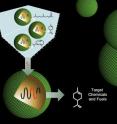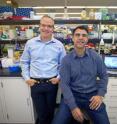CAD for RNA
Related images
(click to enlarge)
The computer assisted design (CAD) tools that made it possible to fabricate integrated circuits with millions of transistors may soon be coming to the biological sciences. Researchers at the U.S. Department of Energy (DOE)'s Joint BioEnergy Institute (JBEI) have developed CAD-type models and simulations for RNA molecules that make it possible to engineer biological components or "RNA devices" for controlling genetic expression in microbes. This holds enormous potential for microbial-based sustainable production of advanced biofuels, biodegradable plastics, therapeutic drugs and a host of other goods now derived from petrochemicals. "Because biological systems exhibit functional complexity at multiple scales, a big question has been whether effective design tools can be created to increase the sizes and complexities of the microbial systems we engineer to meet specific needs," says Jay Keasling, director of JBEI and a world authority on synthetic biology and metabolic engineering. "Our work establishes a foundation for developing CAD platforms to engineer complex RNA-based control systems that can process cellular information and program the expression of very large numbers of genes. Perhaps even more importantly, we have provided a framework for studying RNA functions and demonstrated the potential of using biochemical and biophysical modeling to develop rigorous design-driven engineering strategies for biology."
Keasling, who also holds appointments with the Lawrence Berkeley National Laboratory (Berkeley Lab) and the University of California (UC) Berkley, is the corresponding author of a paper in the journal Science that describes this work. The paper is titled "Model-driven engineering of RNA devices to quantitatively-program gene expression." Other co-authors are James Carothers, Jonathan Goler and Darmawi Juminaga.
Synthetic biology is an emerging scientific field in which novel biological devices, such as molecules, genetic circuits or cells, are designed and constructed, or existing biological systems, such as microbes, are re-designed and engineered. A major goal is to produce valuable chemical products from simple, inexpensive and renewable starting materials in a sustainable manner. As with other engineering disciplines, CAD tools for simulating and designing global functions based upon local component behaviors are essential for constructing complex biological devices and systems. However, until this work, CAD-type models and simulation tools for biology have been very limited.
Identifying the relevant design parameters and defining the domains over which expected component behaviors are exerted have been key steps in the development of CAD tools for other engineering disciplines," says Carothers, a bioengineer and lead author of the Science paper who is a member of Keasling's research groups with both JBEI and the California Institute for Quantitative Biosciences. "We've applied generalizable engineering strategies for managing functional complexity to develop CAD-type simulation and modeling tools for designing RNA-based genetic control systems. Ultimately we'd like to develop CAD platforms for synthetic biology that rival the tools found in more established engineering disciplines, and we see this work as an important technical and conceptual step in that direction."
Keasling, Carothers and their co-authors focused their design-driven approach on RNA sequences that can fold into complicated three dimensional shapes, called ribozymes and aptazymes. Like proteins, ribozymes and aptazymes can bind metabolites, catalyze reactions and act to control gene expression in bacteria, yeast and mammalian cells. Using mechanistic models of biochemical function and kinetic biophysical simulations of RNA folding, ribozyme and aptazyme devices with quantitatively predictable functions were assembled from components that were characterized in vitro, in vivo and in silico. The models and design strategy were then verified by constructing 28 genetic expression devices for the Escherichia coli bacterium. When tested, these devices showed excellent agreement -- 94-percent correlation -- between predicted and measured gene expression levels.
"We needed to formulate models that would be sophisticated enough to capture the details required for simulating system functions, but simple enough to be framed in terms of measurable and tunable component characteristics or design variables," Carothers says. "We think of design variables as the parts of the system that can be predictably modified, in the same way that a chemical engineer might tune the operation of a chemical plant by turning knobs that control fluid flow through valves. In our case, knob-turns are represented by specific kinetic terms for RNA folding and ribozyme catalysis, and our models are needed to tell us how a combination of these knob-turns will affect overall system function."
JBEI researchers are now using their RNA CAD-type models and simulations as well as the ribozyme and aptazyme devices they constructed to help them engineer metabolic pathways that will increase microbial fuel production. JBEI is one of three DOE Bioenergy Research Centers established by DOE's Office of Science to advance the technology for the commercial production of clean, green and renewable biofuels. A key to JBEI's success will be the engineering of microbes that can digest lignocellulosic biomass and synthesize from the sugars transportation fuels that can replace gasoline, diesel and jet fuels in today's engines.
"In addition to advanced biofuels, we're also looking into engineering microbes to produce chemicals from renewable feedstocks that are difficult to produce cheaply and in high yield using traditional organic chemistry technology," Carothers says.
While the RNA models and simulations developed at JBEI to date fall short of being a full-fledged RNA CAD platform, Keasling, Carothers and their coauthors are moving towards that goal.
"We are also actively trying to make our models and simulations more accessible to researchers who may not want to become RNA control system experts but would nonetheless like to use our approach and RNA devices in their own work," Carothers says.
While the work at JBEI focused on E. coli and the microbial production of advanced biofuels, the authors of the Science paper believe that their concepts could also be used for programming function into mammalian systems and cells.
"We recently initiated a research project to investigate how we can use our approach to engineer RNA-based genetic control systems that will increase the safety and efficacy of regenerative medicine therapies that use cultured stem cells to treat diseases such as diabetes and Parkinson's," Carothers says.
This research was supported in part by grants from the DOE Office of Science through JBEI, and the National Science Foundation through the Synthetic Biology Engineering Research Center (SynBERC).
Source: DOE/Lawrence Berkeley National Laboratory
Other sources
- Computer assisted design (CAD) for RNAfrom Science DailyThu, 22 Dec 2011, 20:30:17 UTC
- Researchers develop CAD-Type tools for engineering RNA control systemsfrom PhysorgThu, 22 Dec 2011, 19:01:04 UTC

